Abstract
One hundred and fifty seven infants with progressive ventricular dilatation after intraventricular haemorrhage were randomised to either early repeated cerebrospinal fluid tapping or conservative management. Thirty two (20%) infants died and 13 (8%) were lost to follow up. One hundred and twelve children (90% of survivors) were examined at 30 months by a single experienced examiner. Overall, 54 (48%) scored less than 70 on the Griffiths developmental scales, 101 (90%) had neuromotor impairment, and 85 (76%) had marked disability; 63 (56%) had multiple impairments. Vision was severely affected in 10 (9%) and 30 (27%) had a field defect. Six per cent (seven children) had sensorineural hearing loss and 16 (14%) were taking regular anticonvulsant drugs. Although early cerebrospinal fluid tapping reduced the rate of ventricular and head expansion, there was no statistically significant difference (at the 5% level) between the treatment groups in the prevalence of neuromotor impairments, non-neuromotor impairments, nor multiple impairments at 30 months. These findings were consistent regardless of the presence or absence of a parenchymal cerebral lesion at entry to the trial. In the light of these findings and the 7% risk of cerebrospinal fluid infection associated with repeated tapping, this form of early intervention cannot be recommended.
Full text
PDF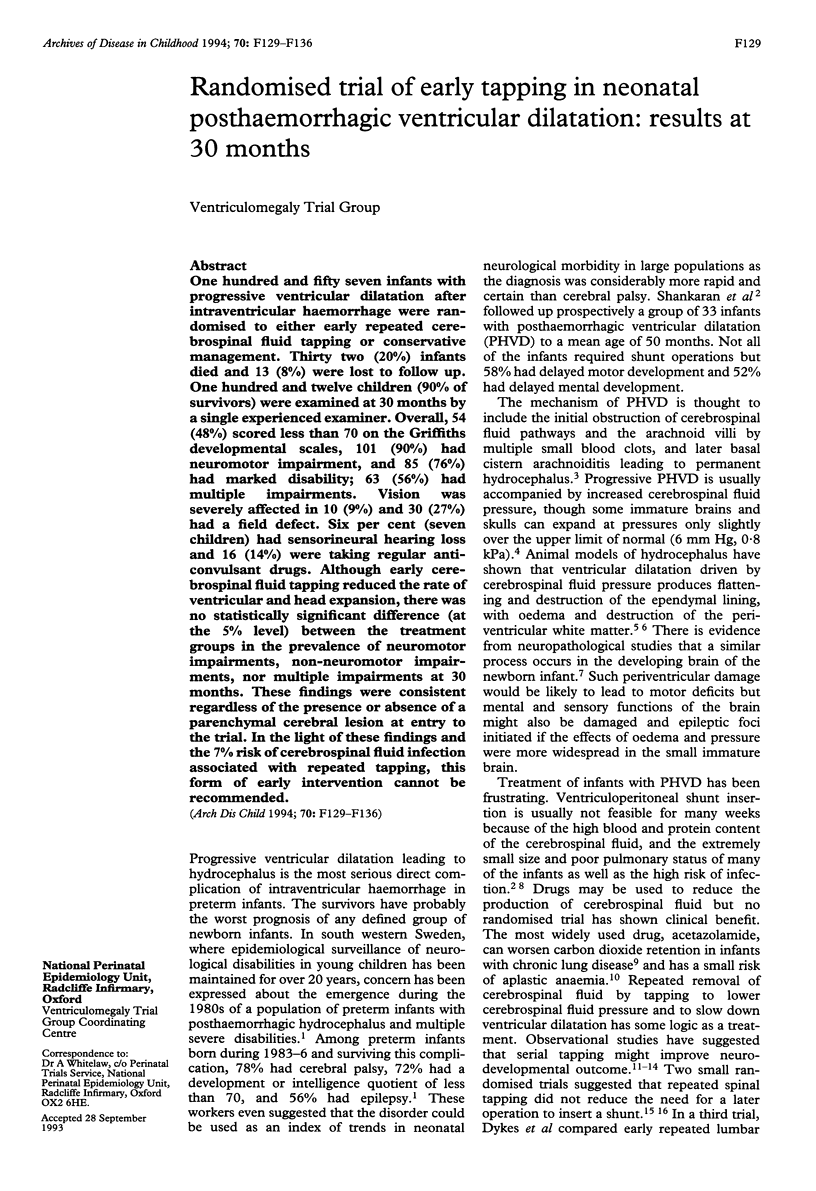
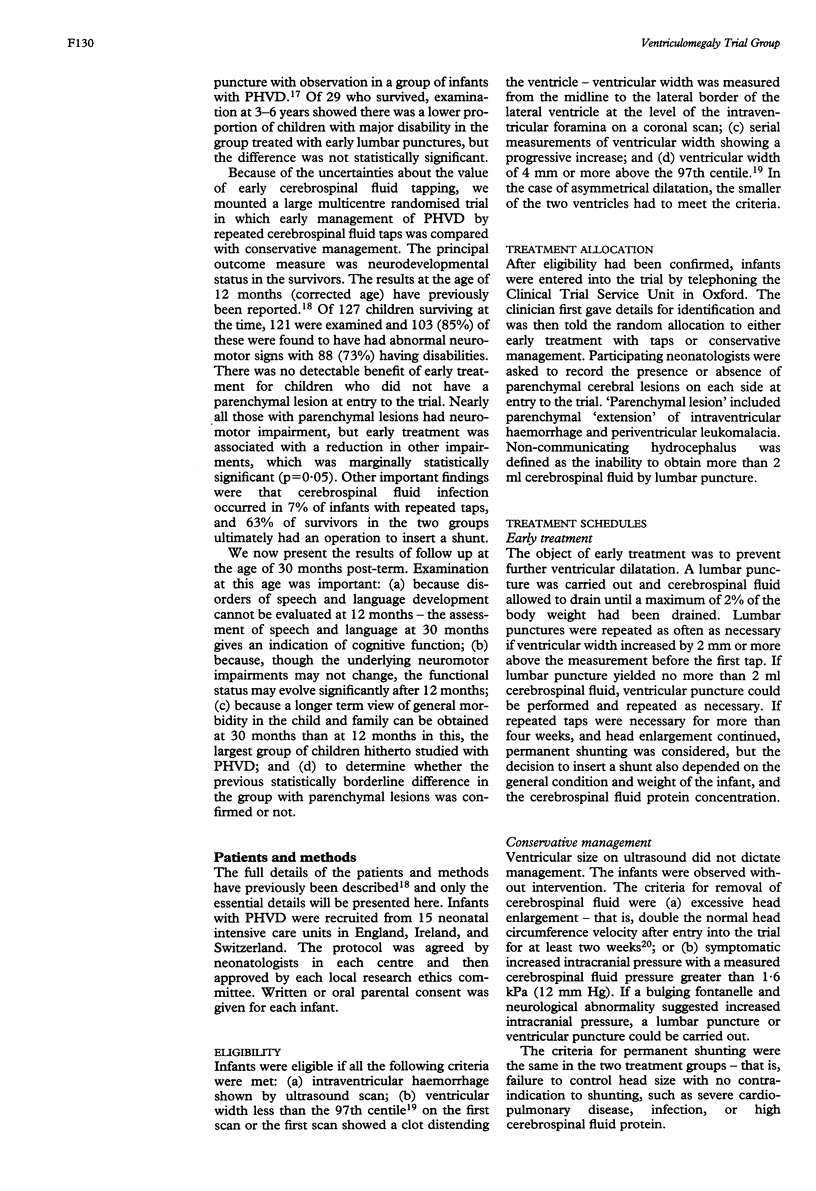
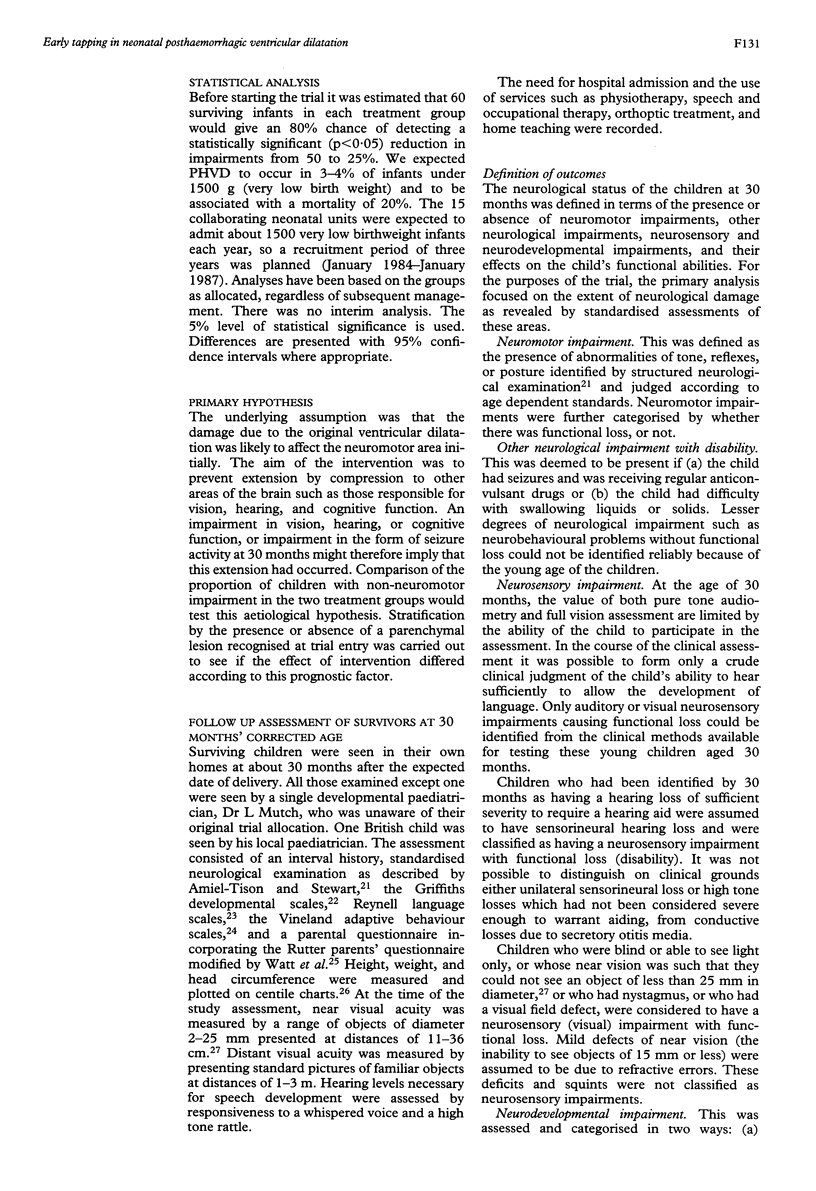
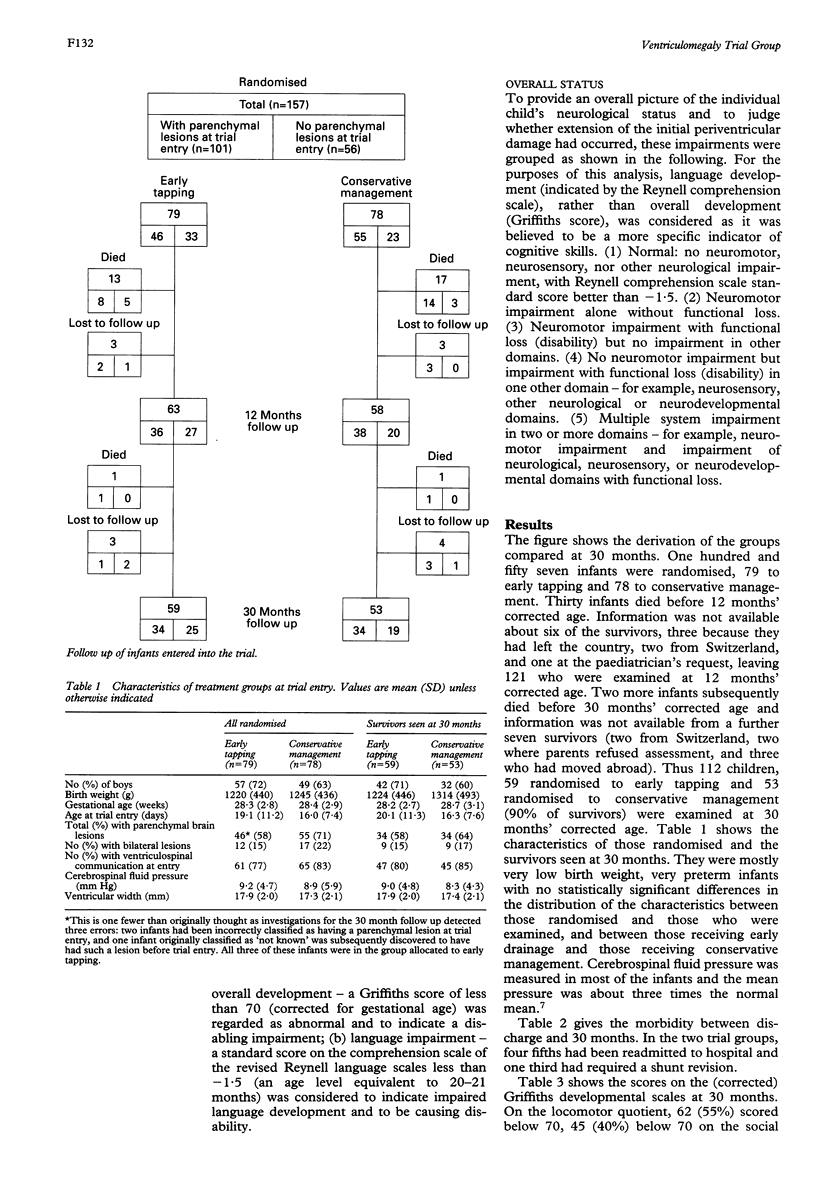
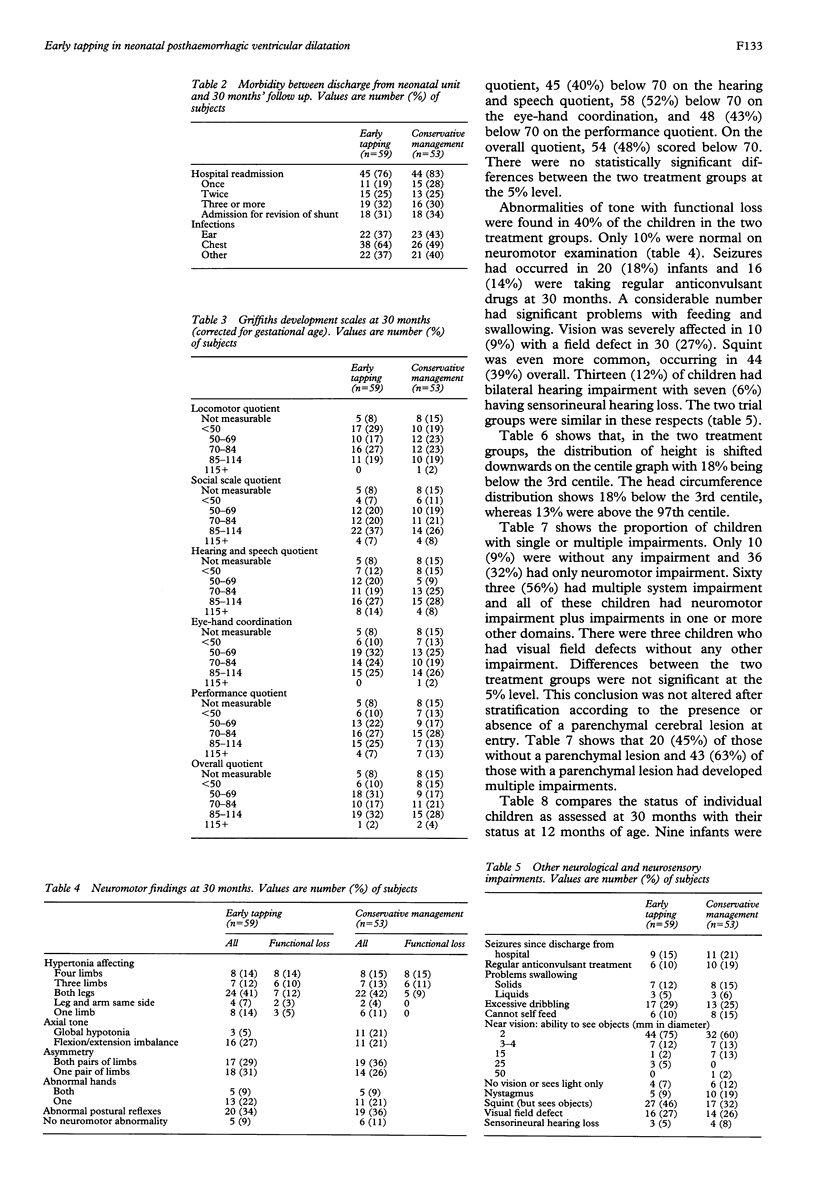
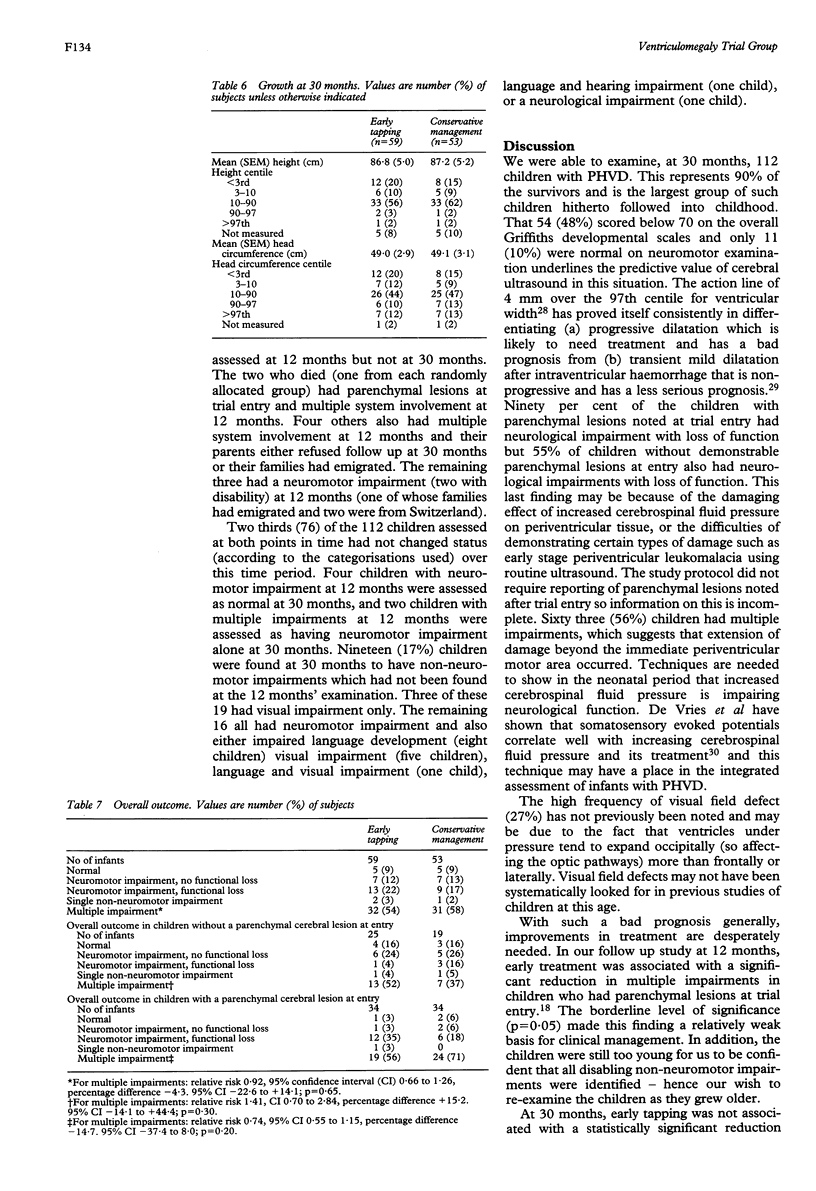
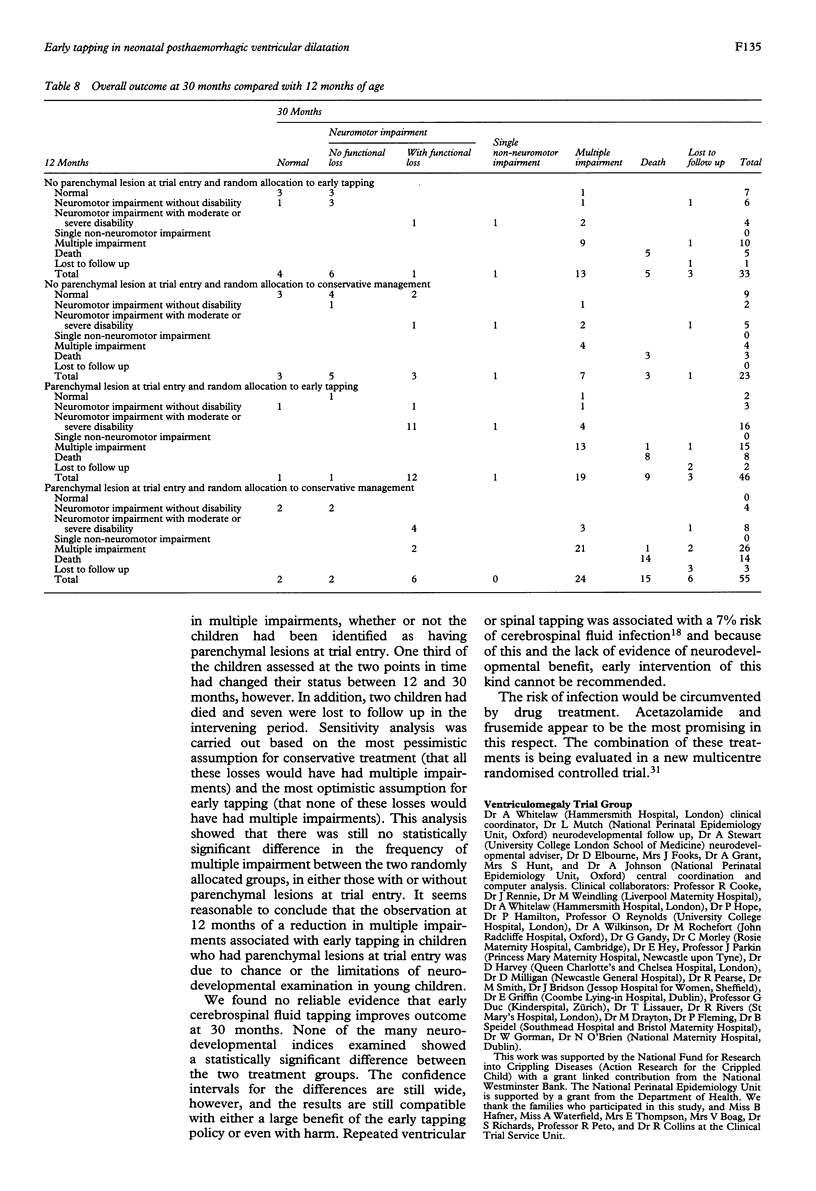
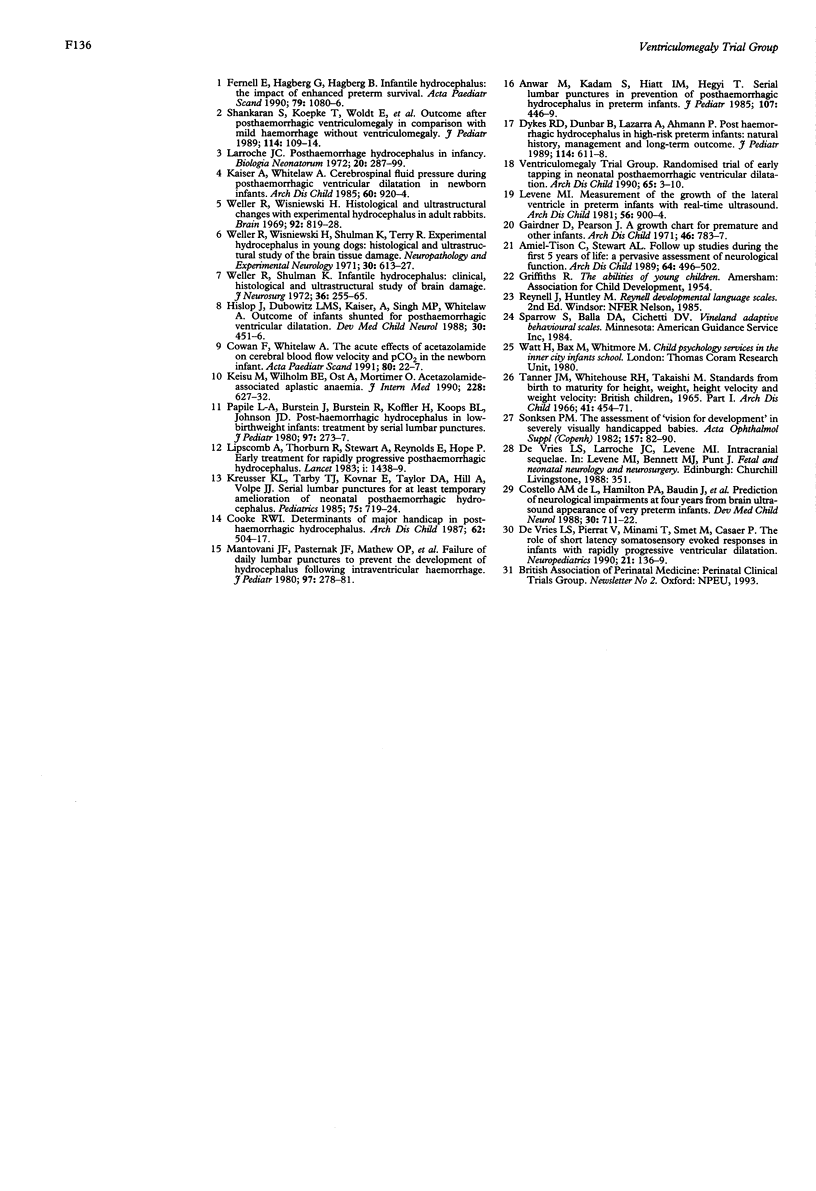
Selected References
These references are in PubMed. This may not be the complete list of references from this article.
- Amiel-Tison C., Stewart A. Follow up studies during the first five years of life: a pervasive assessment of neurological function. Arch Dis Child. 1989 Apr;64(4 Spec No):496–502. doi: 10.1136/adc.64.4_spec_no.496. [DOI] [PMC free article] [PubMed] [Google Scholar]
- Anwar M., Kadam S., Hiatt I. M., Hegyi T. Serial lumbar punctures in prevention of post-hemorrhagic hydrocephalus in preterm infants. J Pediatr. 1985 Sep;107(3):446–450. doi: 10.1016/s0022-3476(85)80532-1. [DOI] [PubMed] [Google Scholar]
- Cooke R. W. Determinants of major handicap in post-haemorrhagic hydrocephalus. Arch Dis Child. 1987 May;62(5):504–506. doi: 10.1136/adc.62.5.504. [DOI] [PMC free article] [PubMed] [Google Scholar]
- Costello A. M., Hamilton P. A., Baudin J., Townsend J., Bradford B. C., Stewart A. L., Reynolds E. O. Prediction of neurodevelopmental impairment at four years from brain ultrasound appearance of very preterm infants. Dev Med Child Neurol. 1988 Dec;30(6):711–722. doi: 10.1111/j.1469-8749.1988.tb14633.x. [DOI] [PubMed] [Google Scholar]
- Cowan F., Whitelaw A. Acute effects of acetazolamide on cerebral blood flow velocity and pCO2 in the newborn infant. Acta Paediatr Scand. 1991 Jan;80(1):22–27. doi: 10.1111/j.1651-2227.1991.tb11724.x. [DOI] [PubMed] [Google Scholar]
- De Vries L. S., Pierrat V., Minami T., Smet M., Casaer P. The role of short latency somatosensory evoked responses in infants with rapidly progressive ventricular dilatation. Neuropediatrics. 1990 Aug;21(3):136–139. doi: 10.1055/s-2008-1071480. [DOI] [PubMed] [Google Scholar]
- Dykes F. D., Dunbar B., Lazarra A., Ahmann P. A. Posthemorrhagic hydrocephalus in high-risk preterm infants: natural history, management, and long-term outcome. J Pediatr. 1989 Apr;114(4 Pt 1):611–618. doi: 10.1016/s0022-3476(89)80707-3. [DOI] [PubMed] [Google Scholar]
- Fernell E., Hagberg G., Hagberg B. Infantile hydrocephalus--the impact of enhanced preterm survival. Acta Paediatr Scand. 1990 Nov;79(11):1080–1086. doi: 10.1111/j.1651-2227.1990.tb11387.x. [DOI] [PubMed] [Google Scholar]
- Gairdner D., Pearson J. A growth chart for premature and other infants. Arch Dis Child. 1971 Dec;46(250):783–787. doi: 10.1136/adc.46.250.783. [DOI] [PMC free article] [PubMed] [Google Scholar]
- Hislop J. E., Dubowitz L. M., Kaiser A. M., Singh M. P., Whitelaw A. G. Outcome of infants shunted for post-haemorrhagic ventricular dilatation. Dev Med Child Neurol. 1988 Aug;30(4):451–456. doi: 10.1111/j.1469-8749.1988.tb04772.x. [DOI] [PubMed] [Google Scholar]
- Kaiser A. M., Whitelaw A. G. Cerebrospinal fluid pressure during post haemorrhagic ventricular dilatation in newborn infants. Arch Dis Child. 1985 Oct;60(10):920–924. doi: 10.1136/adc.60.10.920. [DOI] [PMC free article] [PubMed] [Google Scholar]
- Keisu M., Wiholm B. E., Ost A., Mortimer O. Acetazolamide-associated aplastic anaemia. J Intern Med. 1990 Dec;228(6):627–632. doi: 10.1111/j.1365-2796.1990.tb00290.x. [DOI] [PubMed] [Google Scholar]
- Kreusser K. L., Tarby T. J., Kovnar E., Taylor D. A., Hill A., Volpe J. J. Serial lumbar punctures for at least temporary amelioration of neonatal posthemorrhagic hydrocephalus. Pediatrics. 1985 Apr;75(4):719–724. [PubMed] [Google Scholar]
- Larroche J. C. Post-haemorrhagic hydrocephalus in infancy. Anatomical study. Biol Neonate. 1972;20(3):287–299. doi: 10.1159/000240472. [DOI] [PubMed] [Google Scholar]
- Levene M. I. Measurement of the growth of the lateral ventricles in preterm infants with real-time ultrasound. Arch Dis Child. 1981 Dec;56(12):900–904. doi: 10.1136/adc.56.12.900. [DOI] [PMC free article] [PubMed] [Google Scholar]
- Lipscomb A. P., Thorburn R. J., Stewart A. L., Reynolds E. O., Hope P. L. Early treatment for rapidly progressive post-haemorrhagic hydrocephalus. Lancet. 1983 Jun 25;1(8339):1438–1439. doi: 10.1016/s0140-6736(83)92379-6. [DOI] [PubMed] [Google Scholar]
- Mantovani J. F., Pasternak J. F., Mathew O. P., Allan W. C., Mills M. T., Casper J., Volpe J. J. Failure of daily lumbar punctures to prevent the development of hydrocephalus following intraventricular hemorrhage. J Pediatr. 1980 Aug;97(2):278–281. doi: 10.1016/s0022-3476(80)80495-1. [DOI] [PubMed] [Google Scholar]
- Papile L. A., Burstein J., Burstein R., Koffler H., Koops B. L., Johnson J. D. Posthemorrhagic hydrocephalus in low-birth-weight infants: treatment by serial lumbar punctures. J Pediatr. 1980 Aug;97(2):273–277. doi: 10.1016/s0022-3476(80)80494-x. [DOI] [PubMed] [Google Scholar]
- Shankaran S., Koepke T., Woldt E., Bedard M. P., Dajani R., Eisenbrey A. B., Canady A. Outcome after posthemorrhagic ventriculomegaly in comparison with mild hemorrhage without ventriculomegaly. J Pediatr. 1989 Jan;114(1):109–114. doi: 10.1016/s0022-3476(89)80616-x. [DOI] [PubMed] [Google Scholar]
- Sonksen P. M. The assessment of 'vision for development' in severely visually handicapped babies. Acta Ophthalmol Suppl. 1983;157:82–90. doi: 10.1111/j.1755-3768.1983.tb03936.x. [DOI] [PubMed] [Google Scholar]
- Tanner J. M., Whitehouse R. H., Takaishi M. Standards from birth to maturity for height, weight, height velocity, and weight velocity: British children, 1965. I. Arch Dis Child. 1966 Oct;41(219):454–471. doi: 10.1136/adc.41.219.454. [DOI] [PMC free article] [PubMed] [Google Scholar]
- Weller R. O., Shulman K. Infantile hydrocephalus: clinical, histological, and ultrastructural study of brain damage. J Neurosurg. 1972 Mar;36(3):255–265. doi: 10.3171/jns.1972.36.3.0255. [DOI] [PubMed] [Google Scholar]
- Weller R. O., Wiśniewski H. Histological and ultrastructural changes with experimental hydrocephalus in adult rabbits. Brain. 1969;92(4):819–828. doi: 10.1093/brain/92.4.819. [DOI] [PubMed] [Google Scholar]


